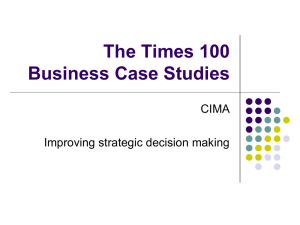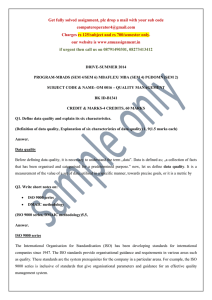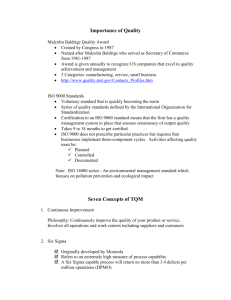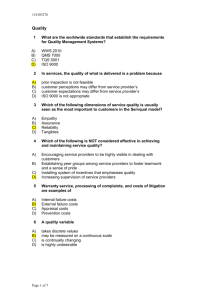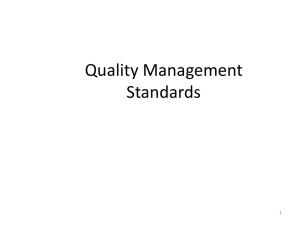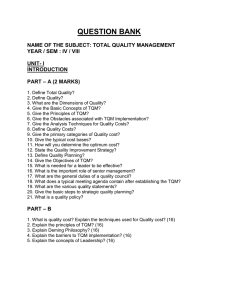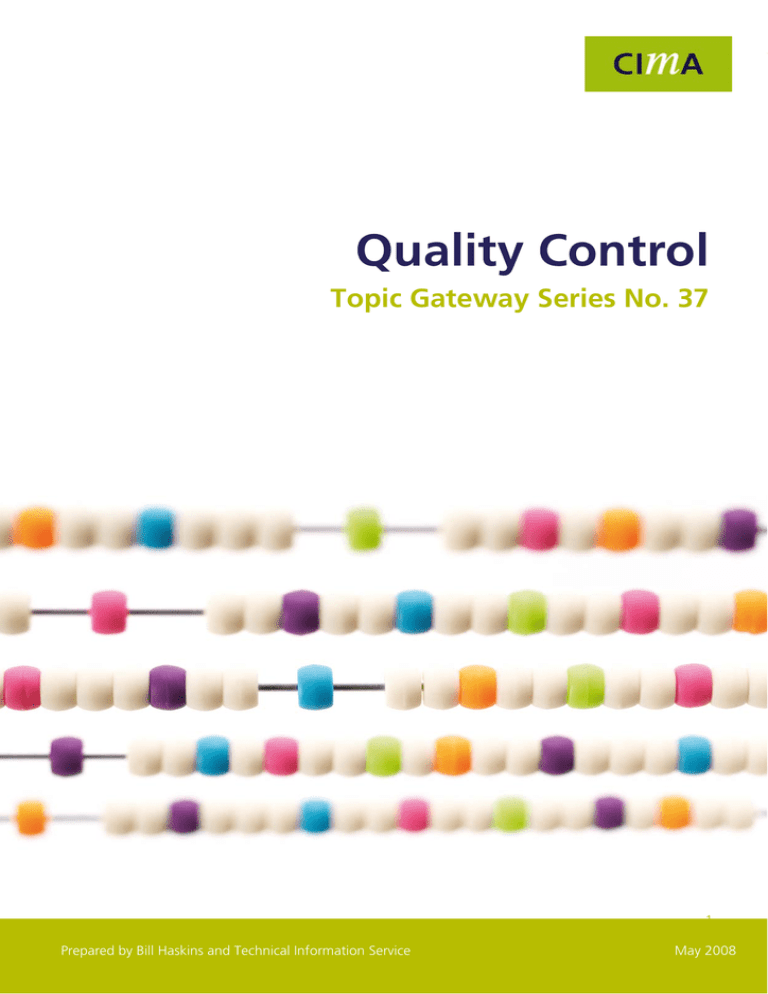
Topic Gateway Series
Quality control
Quality Control
Topic Gateway Series No. 37
1
Prepared by Bill Haskins and Technical Information Service
May 2008
Topic Gateway Series
Quality control
About Topic Gateways
Topic Gateways are intended as a refresher or introduction to topics of interest
to CIMA members. They include a basic definition, a brief overview and a fuller
explanation of practical application. Finally they signpost some further resources
for detailed understanding and research.
Topic Gateways are available electronically to CIMA members only in the CPD
Centre on the CIMA website, along with a number of electronic resources.
About the Technical Information Service
CIMA supports its members and students with its Technical Information Service
(TIS) for their work and CPD needs.
Our information specialists and accounting specialists work closely together to
identify or create authoritative resources to help members resolve their work
related information needs. Additionally, our accounting specialists can help CIMA
members and students with the interpretation of guidance on financial reporting,
financial management and performance management, as defined in the CIMA
Official Terminology 2005 edition.
CIMA members and students should sign into My CIMA to access these services
and resources.
The Chartered Institute
of Management Accountants
26 Chapter Street
London SW1P 4NP
United Kingdom
T. +44 (0)20 8849 2259
F. +44 (0)20 8849 2468
E. tis@cimaglobal.com
www.cimaglobal.com
2
Topic Gateway Series
Quality control
Definition
Definitions of quality include:
‘Fitness for use.’
Joseph Juran
‘The totality of features and characteristics of a product or service that bears on
its ability to meet a stated or implied need.’
ISO 9000
‘The only true measure of acceptable quality is customer satisfaction, which takes
into account both objective and subjective interpretations of the needs and
expectations of customers.’
Chartered Quality Institute
Context
In the current syllabus, CIMA students will learn and may be examined on this
topic in Paper P4, Organisational management and information systems, and
Paper P2, Management accounting decision making.
Overview
There are a number of definitions of quality. To some extent it is a subjective
term and means different things to different organisations. However, the need to
satisfy customers’ requirements is central to most definitions and interpretations
of quality.
Modern management thinking on quality and its strategic importance originates
from the work of W. Edwards Deming. His teachings helped to transform the
Japanese economy after the Second World War. Deming’s ideas on quality
management involved statistical methods and company-wide quality, and led to
the development of the Total Quality Management (TQM) concept.
Joseph Juran was another quality expert. He was influential in transforming the
Japanese economy and helped to shape Western approaches to quality. Philip
Crosby, a leading authority in quality management, developed the concept of
'zero defects.' He also wrote a number of influential books on quality.
3
Topic Gateway Series
Quality control
Kaizen is a Japanese approach involving continuous improvement through small
incremental steps over time. It originated in the 1930s and was successfully
pioneered by Toyota in the 1950s and 1960s. Many of W. Edwards Deming’s
ideas influenced the development of Kaizen.
More recently, Six Sigma, a statistically based methodology, was developed by
Motorola in the 1980s.
In 2000, the ISO 9000:2000 series of quality management standards was
published. These standards are generic and focus on customer satisfaction. There
are now versions of the ISO 9000 series which are aimed at specific industries.
The European Foundation for Quality Management (EFQM) Excellence Model was
introduced in the 1990s. It is one of the most popular self-assessment models for
quality improvement.
Application
Kaizen
Kaizen is a Japanese philosophy and quality management method which involves
continuous improvement through small incremental steps over a long period of
time. Kaizen philosophy encourages an 'instinct for improvement' throughout
the organisation. Improvement is seen as a 'way of life', not just the application
of specific tools and techniques. Senior management commitment is vital for
implementing Kaizen across an organisation. Kaizen can be used in the
development of TQM.
Reported benefits include:
•
quality of a product or service is improved and this is monitored continuously
•
reduction in waste, leading to greater efficiency and lower costs
•
increase in employee morale and job satisfaction
•
continuous monitoring of all organisational functions, by the people most
familiar with each function.
Kaizen involves giving employees tools and techniques for improvement. These
include:
•
Ishikawa fishbone diagram – a cause and effect diagram. This resembles the
skeleton of a fish and shows the causes and sub-causes leading to an effect.
•
Pareto analysis – see section below – 'Other Quality Management Tools'.
4
Topic Gateway Series
Quality control
•
'The five why process' – a technique used for identifying the causes of a
problem by repeatedly asking 'Why?'
•
Forcefield diagrams – used to analyse forces that assist or obstruct the
organisation in reaching a particular objective.
Total Quality Management (TQM)
TQM is a business philosophy, rather than a specific system, tool or process. It is
applied to the whole organisation, and to every activity within the organisation.
The Kaizen concept can be used as a basis for TQM, which encourages
continuous improvement throughout the organisation. TQM involves both the
prevention of errors before they occur, and 'total quality' in the design of
products, services and systems.
TQM gives everyone in the organisation responsibility for quality at every stage of
production, from the initial design stages to after sales service. If a problem is
detected during any stage of the production process, it is solved by that person,
before it affects subsequent production stages. Therefore problems are
eliminated before they impact on the final customer.
Reported benefits of TQM include:
•
greatly improved quality of the final product or service
•
cost savings through a reduction in waste – replacing faulty or damaged
goods or components can be expensive
•
increased productivity, as staff time is used more effectively
•
greater market share due to better products and services, resulting in
competitive advantage.
Reported drawbacks of TQM include the following:
•
it is time consuming
•
it is not a panacea for a failing organisation
•
TQM is not a 'quick fix' – it can take years to implement and will be a
constant process
•
it involves costs, namely capital costs and the costs of retraining staff
•
requires high quality change management.
5
Topic Gateway Series
Quality control
No single methodology or tool is used in TQM, but some of the most common
include:
•
a 'zero defects' policy – a commitment to detailed monitoring and avoiding
errors based on the view that defects are never acceptable
•
quality circles – see section below – 'Other Quality Management Tools'
•
statistical monitoring – evaluation of production processes and quality using
statistical information
•
consumer feedback – market research methods are used to identify
customers’ requirements
•
altering production methods – through changes to production processes or
team structures
TQM has failed in some organisations due to the huge bureaucratic burden
placed on employees. This diverted attention away from normal business
activities. The term TQM is now used less frequently, but the philosophy itself is
still an important part of quality management thinking in organisations.
Six Sigma
Six Sigma is a technique and philosophy designed to reduce waste and improve
performance. It is based on the statistical work of Joseph Juran, and was
pioneered by Motorola in the 1980s.
Six Sigma is a statistical method that involves establishing an ‘optimum
specification’ for each process within an organisation. It then uses statistical
analysis to reduce defects to 'almost zero'. In addition, organisational culture
concentrates on producing value for the customer and abolishing superfluous
processes.
'Sigma' is a statistical term which measures how far a process deviates from
perfection. The higher the sigma number, the closer the process is to perfection.
Six Sigma is 3.4 defects per million, or getting things right 99.999% of the time.
It is possible to develop ways of reducing defects by measuring the level of
defects in a process and discovering the causes.
6
Topic Gateway Series
Quality control
It may not be possible to achieve 'perfect Six Sigma' but significant benefits can
be achieved from a rise from one Sigma level to another.
Reported benefits include:
•
increased quality, productivity, customer satisfaction and competitive
advantage
•
reduction in costs and waste
•
more motivated employees.
Reported drawbacks:
•
may be met with scepticism, as the reported benefits are considerable
•
employees may find it difficult to understand initially
•
costs of training employees
•
cultural change may be required
•
can be time consuming
•
not all processes require such close scrutiny and 'dramatic reengineering'.
Quality standards
External quality standards, such as the ISO 9000 series, are produced by
recognised standard setters. The ISO 9000 series is the best known and is used
globally.
ISO 9000 Series
The ISO 9000 Series is a set of standards for quality management and quality
assurance. They were originally published in 1987 by the International
Organisation for Standardisation (ISO). They were revised in 2000 to place
greater emphasis on customer satisfaction and the fulfilment of customer
requirements.
The ISO 9000 series are not product standards. They are process based rather
than procedurally based – they state what organisations must do to manage the
processes that influence quality.
Reported benefits of ISO 9000:2000 implementation:
•
greater customer satisfaction
•
can be used as a marketing tool
7
Topic Gateway Series
Quality control
•
recognised internationally, and so helpful in export markets
•
help achieve continual improvement
•
can complement TQM.
It should be noted that ISO 9000 is a basis for a quality management system and
not an absolute guarantee of quality. Third party certification is of the system
itself, not the quality.
Other quality standards
The ISO 14000 series is concerned with environmental management systems, and
is closely related to the ISO 9000 series. Texts and information on the ISO 9000
series usually include references to the ISO 14000 series.
Other quality management standards have been developed which are specific to
certain industries and sectors. For example, AS9100 is used in the aerospace
industry, TL9000 is used in telecommunications and QS9000 is applied in the
automotive industry.
Self assessment models
Many organisations use self-assessment models for quality improvement. One of
the best known is the European Foundation for Quality Management (EFQM)
Excellence Model. It enables organisations to measure their performance in key
business areas. The EFQM website explains how the model is based on nine
criteria which are used to assess the organisation’s 'progress towards excellence'.
http://digbig.com/4wxew
[Accessed 13 May 2008]
These criteria are:
Enablers: leadership, policy and strategy, people, partnerships and resources,
processes,
Results: customer results, people results, society results, key performance results.
Using the EFQM Excellence Model helps eliminate subjectivity from
self-assessment. In addition, studies have found that using this model leads to
improved organisational results.
8
Topic Gateway Series
Quality control
Business process re-engineering (BPR)
BPR is often mentioned in discussions and texts on quality. The idea is to increase
an organisation’s performance by radically re-designing organisational structures
and processes. Major change is brought about in a short time and improved
business processes should lead to greater quality. In this way, BPR could be used
as part of a TQM approach.
BPR has been criticised for being used merely as a device for downsizing. The
author R.J. Allis points out that BPR has been ineffective in many organisations
because, having down-sized, management has failed to develop strategies to
redirect resources to encourage growth and competitiveness.
Other quality management tools
Other quality management tools highlighted in CIMA texts include Quality
Circles, 5-S practice and the Pareto rule.
Quality circles
Quality circles consist of small, multidisciplinary groups of staff who meet
regularly to identify and solve quality related problems.
The Pareto rule
This originates from the work of the 19th century Italian economist Vilfredo
Pareto. The Pareto rule suggests that most effects originate from relatively few
causes – 80% of the effects come from 20% of the possible causes. The idea is
to become more effective by concentrating efforts on this vital 20%.
5-S practice
5-S practice encourages effective workplace organisation and standardised work
procedures. It is a philosophy based on five Japanese words which mean
organisation, neatness, cleanliness, standardisation and discipline.
9
Topic Gateway Series
Quality control
References
(2005). CIMA official terminology. Oxford: Elsevier
(2006). Business: the ultimate resource. London: A and C Black
Allio, R.J. (2006). Strategic thinking: the ten big ideas. Strategy and Leadership,
Volume 34, Issue 4, pp 4-13, p.10
American Society for Quality. 2007. [online]. www.asq.org/index.html
[Accessed 13 May 2008]
Armbruster, B. 2005. Keeping up with Kaizen. Shipping Digest, 28/03/2005,
Volume 82, Issue 4283, p. 4
Biz/ed. 2007. [online]. www.bized.co.uk/current/mind/2003_4/100504.htm
[Accessed 13 May 2008]
Chartered Quality Institute. 2007. [online]. www.thecqi.org/
[Accessed 13 May 2008]
CIMA Technical Briefing. 2002. Latest trends in corporate performance
measurement. London: CIMA. http://digbig.com/4wxes
[Accessed 13 May 2008]
European Foundation for Quality Management. 2007. [online].
http://digbig.com/4wxet
[Accessed 13 May 2008]
International Organisation for Standardisation. 2007. [online].
www.iso.org/iso/home.htm
[Accessed 13 May 2008]
Perry, B. (2006). CIMA official learning system, Paper P4, Organisational
management and information systems. 2007 edn. Oxford: Elsevier
Original references include:
Bank, J. (1997). The essence of Total Quality Management. New Jersey: Pearson
Higher Education
Breyfogle, F.W., Cupello, J.M. and Meadows, B. (2001). Managing Six Sigma.
New York: Wiley
Crosby, P. (1979). Quality is free: the art of making quality certain. New York:
McGraw-Hill
10
Topic Gateway Series
Quality control
Crosby, P. (1984). Quality without tears: the art of hassle-free management. New
York: McGraw-Hill
Deming, W. (1986). Out of the crisis: quality, productivity and competitive
position. Cambridge: Cambridge University Press
Eckes, G. (2001). The Six Sigma revolution. New York: Wiley
Further information
CIMA Articles
Scarlet, Bob. Quality streak. CIMA Insider, September 2001, pp 22-23
Available from: http://digbig.com/4wxex
[Accessed 13 May 2008]
Starovic, Danka. Getting Six Sigma right. CIMA Insight, August 2003
Available from: www.cimaglobal.com/insight
[Accessed 13 May 2008]
Other Articles
Full text articles available from Business Source Corporate through My CIMA
www.cimaglobal.com/mycima
[Accessed 13 May 2008]
Briscoe, J.A. The implementation and impact of ISO 9000 among small
manufacturing enterprises. Journal of Small Business Management. July 2005,
Volume 43, Issue 3, pp 309-330
Gluckman, A. Quality in, workers out?: companies adopt Six Sigma. Dollars &
Sense. September/October 2003, Volume 9, pp 15-17
Ho, S.K.M. 5-S practice: the first step towards total quality management. Total
Quality Management, Volume 10, Issue 3, pp 345-356, 12 p. Provides a practical
introduction to 5-S practice and includes a 5-S audit worksheet.
Lemak, D., Mero, N. and Reed, R. When quality works: a premature post-mortem
on TQM. Journal of Business & Management. Fall 2002, Volume 8, Issue 4, p.
391
Maurer, R. Stop me before I Kaizen again. Journal for Quality & Participation.
Summer 2005, Volume 28, Issue 2, p. 37
McQuaig, J.D. Whatever happened to TQM? Wenatchee Business Journal.
October 2004, Volume 18, Issue 10, p. C8
11
Topic Gateway Series
Quality control
Morgan, J. and Brennig-Jones, M. Six Sigma and the future of quality.
Management Services. Summer 2006, Volume 50, Issue 2, pp.46-47
Rahman, S. The future of TQM is past: can TQM be resurrected? Total Quality
Management & Business Excellence. June 2004, Volume 15, Issue 4,
pp 411-422
Soltani, E., Lai, P. and Gharneh, N.S. Breaking through barriers to TQM
effectiveness: lack of commitment of upper-level management. Total Quality
Management & Business Excellence. October/November 2005, Volume 16, Issues
8/9, pp 1009-1021
Van Arnum, P. Quality focus: the next phase of Six Sigma. Chemical Market
Reporter. 15/09/2003, Volume 264, Issue 8, p. FR 10
Warwood, S.J. and Roberts, P.A.B. A survey of TQM success factors in the UK.
Total Quality Management & Business Excellence. October 2004, Volume 15,
Issue 8, pp 1109-1117, 9 p.
Books
Bank, J. (1997). The essence of Total Quality Management. New Jersey: Pearson
Higher Education
Basu, R. and Wright, N. (2003). Quality beyond Six Sigma. Oxford:
Butterworth-Heinemann
Basu, R. (2004). Implementing quality: a practical guide to tools and techniques.
London: Thomson Learning
Beckford, J. (2002). Quality: a critical introduction. London: Routledge
Crosby, P. (1995). Quality without tears: the art of hassle-free management.
London: McGraw-Hill
Dale, B. G. (2003). Managing quality. Oxford : Blackwell
Eckes, G. (2005). Six Sigma execution: how the world's greatest companies live
and breathe Six Sigma. New York: McGraw-Hill Education
Eckes, G. (2003). Six Sigma for everyone. New York: John Wiley & Sons
Hoyle, D. (2005). ISO 9000 quality systems handbook. Oxford: Elsevier Science
Truscott, W. (2003). Six Sigma: continual improvement for businesses.
Oxford: Butterworth-Heinemann
12
Topic Gateway Series
Quality control
Case Studies
Available from Business Source Corporate through My CIMA
www.cimaglobal.com/mycima
[Accessed 13 May 2008]
Laszlo, G. ISO 9000 or TQM: which approach to adopt – a Canadian case study.
Strategic Change, March/April 1999, Volume 8, Issue 2, pp 81-86, 6 p.
Rao, M.P., Youssef, M.A. and Stratton, C.J. Can TQM lift a sinking ship?: a case
study. Total Quality Management & Business Excellence. March 2004, Volume
15, Issue 2, pp 161-171
Rasis, D., Gitlow, H.S. and Popovich, E. Paper Organizers International: a fictitious
Six Sigma green belt. Case Study I. Quality Engineering. 2002, Volume 15, Issue
1, pp 127-145
Rasis, D., Gitlow, H.S. and Popovich, E. Paper Organizers International: a fictitious
Six Sigma green belt. Case Study II. Quality Engineering. 2002. Volume 15, Issue
2, pp 259-274
CIMA Mastercourses
Achieving process excellence: Six Sigma process improvement. To book via
www.cimamastercourses.com please go to Find and key in the course code
SSIG.
13
Topic Gateway Series
Quality control
Websites
American Society for Quality (ASQ)
ASQ is a membership organisation dedicated to quality. www.asq.org
[Accessed 13 May 2008]
Chartered Quality Institute (CQI)
The CQI is the only chartered professional body dedicated to quality.
www.thecqi.org/
[Accessed 13 May 2008]
European Foundation for Quality Management (EFQM)
EFQM is a not-for-profit membership foundation. www.efqm.org
[Accessed 13 May 2008]
International Organization for Standardization (ISO)
The ISO website explains the function of the ISO, the ISO 900 / ISO
14000, and ISO products and services. www.iso.org/iso/home.htm
[Accessed 13 May 2008]
First published in 2007 by:
No responsibility for loss occasioned to any person acting or refraining from
action as a result of any material in this publication can be accepted by the
authors or the publishers.
The Chartered Institute
of Management Accountants
26 Chapter Street
London SW1P 4NP
United Kingdom
All rights reserved. No part of this publication may be reproduced, stored
in a retrieval system, or transmitted, in any form or by any means method
or device, electronic (whether now or hereafter known or developed),
mechanical, photocopying, recorded or otherwise, without the prior 14
permission of the publishers.
Printed in Great Britain
Permission requests should be submitted to CIMA at tis@cimaglobal.com
Copyright ©CIMA 2007

